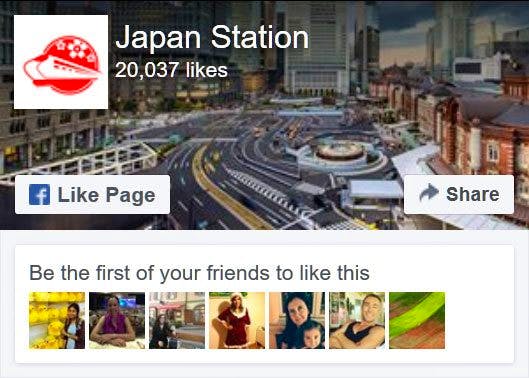The Keihin-Tohoku Line is a rail line operated by JR East that runs north to south through three prefectures: Saitama, Tokyo, and Kanagawa. In Tokyo this line runs parallel to the Yamanote Line between Tabata and Shinagawa Stations. Along this section you can cross the platform to transfer between the Keihin-Tohoku and Yamanote lines at Tabata, Ueno, Akihabara, Kanda, Tokyo, Hamamatsucho, and Tamachi stations.
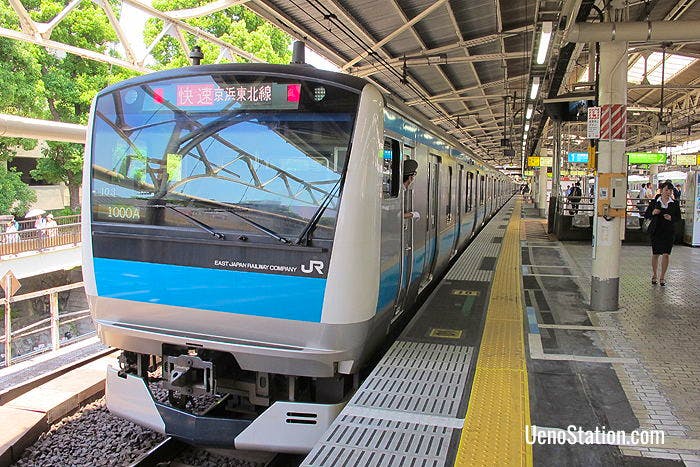
A Rapid Train bound for Minami-Urawa at Platform 1 JR Ueno Station
All trains on the Keihin-Tohoku Line are through services which run beyond the line’s southern terminus at Yokohama Station and continue on the Negishi Line as far as Ofuna Station in Kamakura. Maps and signage for the Keihin-Tohoku and Negishi lines are therefore given the same color-coding of light blue and trains on these lines can also be identified by their light blue stripe.
Train services on the Keihin-Tohoku Line are very regular and run every 2 to 3 minutes during peak travel periods. This rail line is covered by the Japan Rail Pass. At JR Ueno Station north-bound trains on this line depart from Platform 1 and south-bound trains depart from Platform 4.
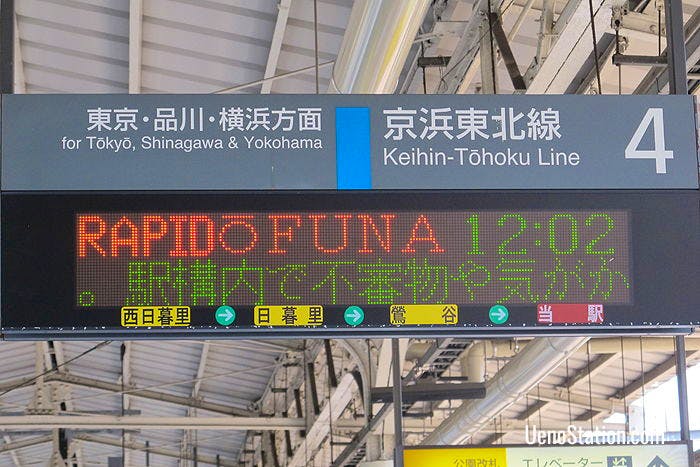
Departure information at Platform 4 JR Ueno Station
Keihin-Tohoku Line & Negishi Line Stations
The Keihin-Tohoku Line runs between Omiya Station in Saitama Prefecture and Yokohama Station in Kanagawa Prefecture with stops at the following 35 stations. Local trains will stop at all stations, but weekday rapid services in the Tokyo section of the line do not stop at Nishi-Nippori, Nippori, Uguisudani, Okachimachi, Yurakucho and Shimbashi stations. Rapid services on weekends and holidays do stop at Okachimachi Station.
Omiya – Saitama-Shintoshin – Yono – Kita-Urawa – Urawa – Minami-Urawa – Warabi – Nishi-Kawaguchi – Kawaguchi – Akabane – Higashi-Jujo – Oji – Kami-Nakazato – Tabata – Nishi-Nippori – Nippori – Uguisudani – Ueno – Okachimachi – Akihabara – Kanda – Tokyo – Yurakucho – Shimbashi – Hamamatsucho – Tamachi – Shinagawa – Oimachi – Omori – Kamata – Kawasaki – Tsurumi – Shin-Koyasu – Higashi-Kanagawa – Yokohama
All services on the Keihin-Tohoku Line are through services that continue beyond Yokohama Station onto the Negishi Line stopping at the following 12 stations.
Yokohama – Sakuragicho – Kannai – Ishikawacho – Yamate – Negishi – Isogo – Shin-Sugita – Yokodai – Konandai – Hongodai – Ofuna
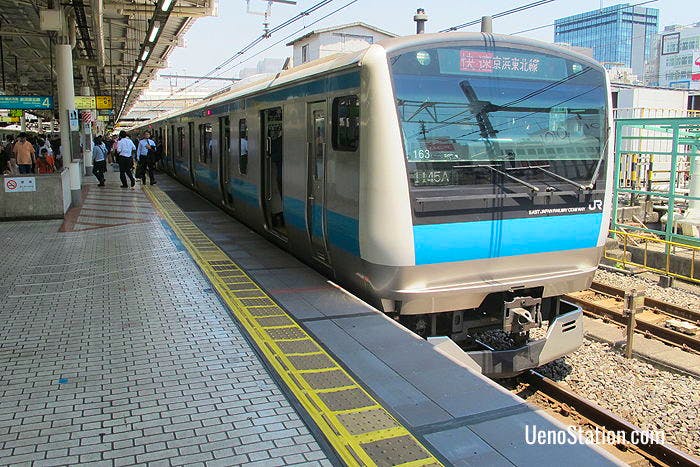
A Rapid train bound for Ofuna at Platform 4 JR Ueno Station
Key Destinations
The key destinations along both the Keihin-Tohoku and Negishi lines are given below with information on their main attractions and transfer points. Fares and example train times are given from Omiya Station.
Saitama Prefecture Stops
Omiya Station
Attractions in Omiya include Hikawa Shrine (which is said to be 2,400 years old), Omiya Railway Museum, Omiya Bonsai Village, the Japan Mint Museum, and Saitama Prefectural Museum of History and Folklore.
Transfers can be made here to the Tobu Urban Park Line, Saitama New Urban Transit’s “New Shuttle” on the Ina Line and the following JR lines: the Utsunomiya Line, the Takasaki Line, the Shonan-Shinjuku Line, the Saikyo Line and the Kawagoe Line. The following shinkansen services all run from Omiya Station: the Tohoku Shinkansen, the Yamagata Shinkansen, the Akita Shinkansen, the Joetsu Shinkansen, and the Hokuriku Shinkansen.
Saitama-Shintoshin Station
Exit here for sports and music events at Saitama Super Arena. Transfer here to JR East’s Utsunomiya Line and Takasaki Line.
Train fare: 140 yen
Train time: 2 minutes
Kita-Urawa Station
The Museum of Modern Art, Saitama (MOMAS) is a 3 minute walk from this station. Set amongst the greenery of Kita-Urawa Park MOMAS was designed by the leading Metabolist architect Kisho Kurokawa and it houses works by leading international and Japanese artists.
Train fare: 160 yen
Train time: 7 minutes
Urawa Station
Transfer here to JR East’s Utsunomiya Line, Takasaki Line and Shonan-Shinjuku Line.
Train fare: 170 yen
Train time: 9 minutes
Minami-Urawa Station
Transfer here to JR East’s Musashino Line.
Train fare: 170 yen
Train time: 12 minutes
Kawaguchi Station
Kawaguchi’s main attractions are the park and botanical garden at Kawaguchi Green Center and the Former Tanaka Family Residence; a Taisho era red-brick building which is of interest for its blend of Japanese and Western styles of architecture and interior design.
Train fare: 220 yen
Train time: 21 minutes
Tokyo Metropolis Stops
Akabane Station
Transfers can be made here to JR East’s Utsunomiya Line, Takasaki Line, Shonan-Shinjuku Line, and Saikyo Line.
Train fare: 310 yen
Train time: 24 minutes
Oji Station
Oji is a pleasant area of greenery, shrines and museums in the Kita Ward of northern Tokyo. Just outside the station is the Asukayama Park which is known for its cherry blossoms in the springtime.
Inside the park you can find three museums. The Paper Museum has exhibits related to 2,000 years of paper history including traditional Japanese washi paper, the development of industrial paper manufacturing, paper recycling and associated environmental matters. The Shibusawa Memorial Museum is dedicated to the Meiji era industrialist and “father of Japanese capitalism” Shibusawa Eiichi. The Asukayama Museum is dedicated to local art, culture and history.
Within the park you can also find two preserved railway vehicles: a D51 steam locomotive which was retired in 1972 and an old Toden Arakawa Line tram car which was retired in 1978.
North west of the station are two shrines: Oji Jinja Shrine which is most famous for its giant Gingko tree, and Oji Inari Jinja Shrine which is a legendry gathering place for fox spirits. Every year from midnight on New Year’s Eve an annual costume parade of people wearing fox masks is held from nearby Shozoku Inari Jinja Shrine to Oji Inari Jinja Shrine to celebrate the new year. Just north of Oji Inari Jinja is Nanushinotaki Park, a traditional Japanese stroll garden which is completely free to enter. Transfers can be made at Oji Station to Tokyo Metro’s Namboku Line and the Toden Arakawa Tram Line.
Train fare: 390 yen
Train time: 29 minutes
Kami-Nakazato Station
Exit here for the Kyu-Furukawa Gardens, a Western style manor house built in 1917 surrounded by park land which includes a rose garden, a rhododendron plantation, and a traditional Japanese stroll garden and pond.
Train fare: 390 yen
Train time: 31 minutes
Tabata Station
In the early 20th century Tabata was the center of a rich community of artists, novelists and poets. Most prominent among these was the celebrated writer Akutagawa Ryunosuke, who was nicknamed “the king of Tabata”. Today this rich cultural legacy is celebrated at the Tabata Memorial Museum of Writers and Artists which holds 3,000 objects including paintings, ceramics, letters and original manuscripts. Admission is free and the museum is just a 2 minute walk from Tabata Station.
Transfers can be made at Tabata Station to JR East’s Yamanote Line.
Train fare: 390 yen
Train time: 35 minutes
Nishi-Nippori Station
Transfers can be made here to JR East’s Yamanote Line, Tokyo Metro’s Chiyoda Line, and the Nippori-Toneri Liner.
Train fare: 390 yen
Train time: 36 minutes
Nippori Station
Exit here for Yanaka Ginza; a traditional shopping street, Yanaka cemetary which is known for the beauty of its cherry blossoms in the spring, Tennoji Temple which dates form 1274, and the view from “Yuyake Dandan” which literally means “Sunset Stairs”.
Transfers can at Nippori Station to JR East’s Yamanote Line and Joban Line, the Keisei Main Line, and the Nippori-Toneri Liner.
Train fare: 390 yen
Train time: 37 minutes
Uguisudani Station
Transfers can be made here to JR East’s Yamanote Line.
Train fare: 470 yen
Train time: 39 minutes
Ueno Station
Ueno is famous in Tokyo for its large park, its many museums and its zoo. There are also many shrines and temples in this area.
Ueno Station is a major transportation hub with connections to JR East’s Yamanote, Utsunomiya, Takasaki, Joban, and Ueno-Tokyo lines; the Tohoku,Yamagata, Akita, Joetsu, Hokkaido and Hokuriku shinkansen services; Tokyo Metro’s Ginza and Hibiya lines; and the Keisei Main Line.
Train fare: 470 yen
Train time: 41 minutes
Okachimachi Station
Exit here for Ameya-Yokocho; a busy shopping street full of cheap eateries and bargain stores that runs back up towards Ueno Station. Transfers can be made here to JR East’s Yamanote Line, the Toei Oedo Line, and Tokyo Metro’s Ginza and Hibiya lines.
Train fare: 470 yen
Train time: 43 minutes
Akihabara Station
Exit here for the Akihabara district which is famous for its cheap electronics stores, shops selling manga, anime, games, and cosplay goods, and also maid cafes where customers are served by girls dressed in French maid costumes. Transfers can be made here to JR East’s Yamanote Line and Chuo-Sobu Line, the Tokyo Metro Hibiya Line, and the Tsukuba Express.
Train fare: 470 yen
Train time: 45 minutes
Kanda Station
The Mitsui Memorial Museum is an 8 minute walk from Kanda Station. This museum exhibits many Japanese and Asian art treasures that were collected by the Mitsui family. Transfers can be made here to JR East’s Yamanote Line and Chuo Line, and the Tokyo Metro Ginza Line.
Train fare: 470 yen
Train time: 48 minutes
Tokyo Station
Tokyo Station itself is a historic building dating from 1914. The preserved red brick exterior of the station can be viewed by exiting from the western Marunouchi side. The Marunouchi side also faces onto the grounds of the Imperial Palace, some gardens of which are accessible to the public. The nearby Mitsubishi Ichigokan Museum is a Queen Anne style building designed in 1894 by the British architect Josiah Conder. To fit the museum building’s own history it exhibits mainly 19th century European art. The Yaesu exit on the east side of the Tokyo Station building is more contemporary in appearance and opens onto the Tokyo Station City commercial complex which houses a variety of shopping and dining facilities.
Transfers can be made at Tokyo Station to the following JR services: the Yamanote Line, the Chuo Line, the Tokaido Line, the Ueno-Tokyo Line, the Sobu Line, the Yokosuka Line and the Keiyo Line. The Tokaido, Tohoku, Joetsu, and Hokuriku shinkansen all run from this station. Transfers can also be made here to the Tokyo Metro Marunouchi Line.
Train fare: 550 yen
Train time: 50 minutes
Yurakucho Station
Exit here for the convention center and performance venue Tokyo International Forum. Under the rail tracks just outside the station is the lively Gadoshita area which is crammed with cheap eateries and drinking venues. Transfers can be made at Yurakucho Station to JR East’s Yamanote Line, Tokyo Metro’s Yurakucho, Hibiya, and Chiyoda lines, and the Toei Mita Line.
Train fare: 550 yen
Train time: 52 minutes
Shimbashi Station
Shimbashi Station is a place of pilgrimage for railway enthusiasts and historians. The original Shimbashi Station opened in 1872 and it was the Tokyo terminus of Japan’s first railway which ran between Tokyo and Yokohama. Old Shimbashi Station is a reconstruction of this building which has been built on the original location and it houses a railway history exhibition hall. It is a 5 minute walk east of the modern Shimbashi Station. Displayed outside the west side of the modern station is an old steam locomotive dating from 1945 which was installed here in 1972 to commemorate the 100th anniversary of Shimbashi Station’s opening.
Transfers can be made at Shimbashi Station to the following JR services: the Yamanote Line, the Tokaido Line, and the Yokosuka Line. Transfers can also be made to the Tokyo Metro Ginza Line, the Toei Asakusa Line, and New Transit Yurikamome.
Train fare: 550 yen
Train time: 54 minutes
Hamamatsucho Station
This station is convenient for two of Tokyo’s most celebrated gardens the Kyu Shiba Rikyu Garden and Hamarikyu Gardens. Zozoji is an impressive temple which is a 13 minute walk west of the station. Transfers can be made here to JR East’s Yamanote Line and the Tokyo Monorail. At nearby Daimon Station transfers can be made to the Toei Asakusa Line and the Toei Oedo Line.
Train fare: 550 yen
Train time: 56 minutes
Tamachi Station
Transfers can be made here to JR East’s Yamanote Line, the Toei Asakusa Line and the Toei Mita Line.
Train fare: 550 yen
Train time: 59 minutes
Shinagawa Station
The most famous location near Shinagawa Station is Sengakuji Temple. In the graveyard of this temple are the tombs of the legendary 47 Ronin. These were a group of heroic samurai who became famous for taking revenge on the man responsible for the death of their master. Their story became a popular topic of kabuki drama and bunraku puppet plays and a festival is held here every December 14th to commemorate their loyalty. Sengakuji Temple is a 15 minute walk north of Shinagawa station.
There are also a variety of interesting museums within walking distance of Shinagawa Station. The Nikon Museum is just 8 minutes to the east of the station and a must-see for photography enthusiasts. There are many interactive displays detailing the history, technology and design principles of the Nikon company and a “hands-on” section exhibiting rare and valuable cameras. 15 minutes’ walk south of the station will take you to the Hara Museum. Housed in a Bauhaus building dating from 1938 this museum is dedicated to contemporary art, architecture, design, music and dance. Just one minute from the Hara Museum is the Jade Ore Museum (Hisuigensekikan) which exhibits a large private collection of jade pieces cut and uncut in all shapes and sizes. This museum has no English display information, but it is the only museum of its kind in Japan and many of the displayed pieces are for sale. 18 minutes to the west of Shinagawa Station is the Hatakeyama Memorial Museum of Fine Art, which exhibits a collection of Chinese, Korean, and Japanese art works related to the tea ceremony.
Transfers can be made at Shinagawa Station to the JR Yamanote Line, the JR Yokosuka Line, the JR Tokaido Line, the Tokaido Shinkansen, and the Keikyu Main Line.
Train fare: 640 yen
Train time: 1 hour and 2 minutes
Oimachi Station
Transfers can be made here to the Tokyu Oimachi Line which runs to Kawasaki and the Rinkai Line which connects central Tokyo to Aomi and Odaiba.
Train fare: 640 yen
Train time: 1 hour and 5 minutes
Omori Station
Exit here for Shinagawa Historical Museum. This museum of local history displays archaeological finds from the nearby Omori Shell Mounds. Other exhibits are related to the Shinagawa Post Station which was the first stop on the old Tokaido highway that connected Tokyo (then called “Edo”) with Kyoto. The Omori Shell Mounds Park is 8 minutes’ walk north of Omori Station and the museum is 7 minutes’ walk north of the park.
Train fare: 720 yen
Train time: 1 hour and 8 minutes
Kamata Station
Transfers can be made here to the Tokyu Ikegami Line and the Tokyu Tamagawa Line. Keikyu Kamata Station is 11 minutes’ walk east of this station and is served by the Keikyu Main Line and Keikyu Aiport Line.
Train fare: 720 yen
Train time: 1 hour and 11 minutes
Kanagawa Prefecture Stops
Kawasaki Station
Kawasaki is a city in Kanagawa Prefecture. Top attractions here are Kawasaki Daishi which is a large and popular temple dating from 1128, Nihon Minka-en (or Japan Open Air Folk House Museum) which is a park with many traditional thatched minka farm houses, and the Fujiko F. Fujio Museum which is dedicated to the creator of the popular cartoon character Doraemon. Toshiba Science Museum is a free museum of interactive historical and technological displays which is just 5 minutes’ walk from Kawasaki Station.
Transfers can be made here to the JR Tokaido Line, and the JR Nambu Line. At nearby Keikyu Kawasaki Station transfers can be made to the Keikyu Main Line, and the Keikyu Daishi Line.
Train fare: 800 yen
Train time: 1 hour and 16 minutes
Tsurumi Station
Exit here for Sojiji Temple, one of the main temples of the Soto school of Zen Buddhism. Originally founded in the 8th century on the Noto Peninsula in Ishikawa Prefecture, the temple was moved here in the early 20th century after a fire destroyed the original buildings. Today the temple has a welcoming attitude to international visitors so temple tours with monks as guides or English language Zazen meditation sessions are both available. The temple is a 7 minute walk west of the station.
Transfers can be made at Tsurumi Station to JR East’s Tsurumi Line and at nearby Keikyu Tsurumi Station to the Keikyu Main Line.
Train fare: 920 yen
Train time: 1 hour and 19 minutes
Shin-Koyasu Station
Transfers can be made to the Keikyu Main Line at nearby Keikyu Shinkoyasu Station.
Train fare: 920 yen
Train time: 1 hour and 23 minutes
Higashi-Kanagawa Station
Transfers can be made here to JR East’s Yokohama Line and to the Keikyu Main Line at nearby Nakakido Station.
Train fare: 920 yen
Train time: 1 hour and 27 minutes
Yokohama Station
Yokohama is the capital city of Kanagawa Prefecture. Top attractions here include Yokohama Chinatown, the traditional Sankeien Garden, the Minato Mirai harbor district with its many towering skyscrapers and observatories, the Cosmo amusement park and waterfront Ferris wheel, and the Motomachi and Yamate areas which have many historical western style residential buildings.
Transfers can be made at Yokohama Station to the following JR services: the Yokohama Line, the Yokosuka Line, Shonan-Shinjuku Line, and the Tokaido Line. Transfers can also be made to the Tokyu Toyoko Line, the Keikyu Main Line, the Sotetsu Main Line, the Yokohama Municipal Subway Blue Line, and the Minatomirai Line.
Train fare: 920 yen
Train time: 1 hour and 29 minutes
Negishi Line Stops
All services on the Keihin-Tohoku Line are through services which continue beyond Yokohama Station on the JR Negishi Line. The Negishi Line links locations in Yokohama with Ofuna Station in Kamakura City.
Sakuragicho Station
Sakuragicho Station is the location of the original Yokohama Station which opened in 1872 and is one of the oldest stations in Japan. This station is convenient for the Minato Mirai district and Yokohama Landmark Tower. Transfers can be made here to the Yokohama Municipal Subway Blue Line.
Train fare: 1,080 yen
Train time: 1 hour and 35 minutes
Kannai Station
Transfers can be made here to the Yokohama Municipal Subway Blue Line.
Train fare: 1,080 yen
Train time: 1 hour and 37 minutes
Ishikawacho Station
This station is convenient for Yokohama Chinatown and the Motomachi district.
Train fare: 1,080 yen
Train time: 1 hour and 39 minutes
Negishi Station
Yokohama Municipal Tram Museum is a 17 minute walk from Negishi Station.
Train fare: 1,080 yen
Train time: 1 hour and 43 minutes
Shin-Sugita Station
Transfers can be made here to the Kanazawa Seaside Line and the Keikyu Main Line at nearby Sugita Station.
Train fare: 1,250 yen
Train time: 1 hour and 49 minutes
Ofuna Station
Ofuna Station is in Kamakura City which is popular with tourists for its seaside location and many historical shrines and temples. Josenji Temple and the Taya Caves are a 14 minute bus ride from the west exit of Ofuna Station. The caves were dug into a limestone hill by the monks of Josenji as a unique place for meditation and inside they are decorated with ancient Buddhist carvings. Ofuna Kannon Temple with its 25 meter high statue of the goddess of mercy is a 5 minute walk from the station’s west exit.
Transfers can be made here to the JR Tokaido Line, the JR Shonan-Shinjuku Line, the JR Yokosuka Line, and the Shonan Monorail. To explore Kamakura further take the Yokosuka Line to Kita-Kamakura Station and Kamakura Station as many shrines and temples are concentrated in those areas.
Train fare: 1,250 yen
Train time: 2 hours and 2 minutes
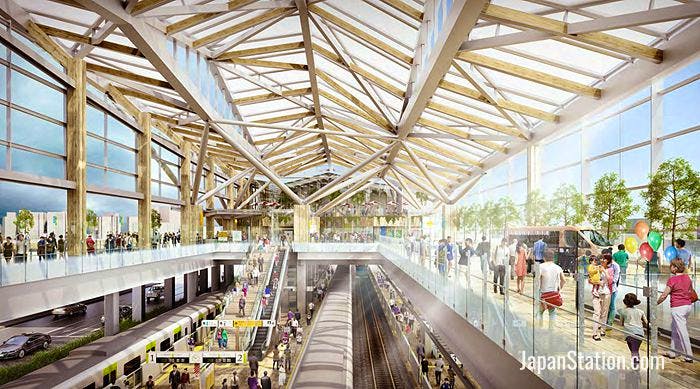
An artist’s impression of the new Keihin-Tohoku Line Station
Future Plans: “Shinagawa Shin-Eki”
A new station between Tamachi Station and Shinagawa Station on the Keihin-Tohoku Line is currently under construction and is due to open in time for the Tokyo Olympics in 2020. This station will serve both the Keihin-Tohoku and Yamanote lines and is notable for being designed by the Olympic Stadium architect, Kengo Kuma. Although the new station has been provisionally named “Shinagawa Shin-Eki”, its final name has not yet been decided. For more details and images of this station see our article First Images of the New Shinagawa Station.
Useful Links
Though the Keihin-Tohoku Line links Tokyo with Yokohama it is not always the fastest route between these destinations, and it is often quicker to transfer between lines on the way. You can use English language route finders such as the Japan Transit Planner or Hyperdia to find the fastest route for your journey.
Article and original photos by Michael Lambe. All rights reserved.
